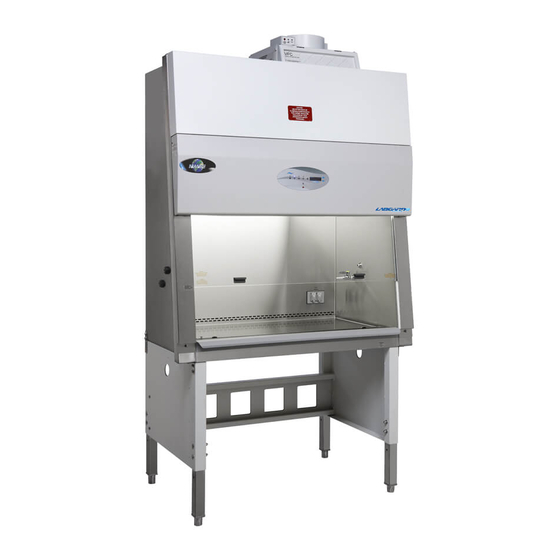Table of Contents
Advertisement
LabGard® ES Energy Saver
Class II Laminar Flow
Biosafety Cabinet
Models
NU-543-300S/400S/500S/600S
Bench/Console
Operation and Maintenance Manual
April 2021
Revision 10
Series 1
Manufactured By:
NuAire, Inc.
2100 Fernbrook Lane
Plymouth, MN 55447
Toll-Free: 1-800-328-3352
In Minnesota: (763)-553-1270
Fax: (763)-553-0459
OM0239
Page 1 of 72
Advertisement
Table of Contents

Summarization of Contents
General Information
Description
Describes the LabGard® ES Model NU-543S LFBSC, its function, and Class II requirements.
Safety Instructions
Explanation of Symbols
Explains the meaning of various safety alert symbols used in the manual.
Warranty
Damaged Shipments
Outlines procedures for handling shipments that may have sustained damage.
Installation Instructions
Location
Details the ideal placement and necessary clearances for the biosafety cabinet.
Set-Up Instructions
Covers base stand assembly, leveling, bench installation, gas service, and final assembly.
Operating the NU-543S
FlowGard™ Control System
Overview of the control system, its functions, and components.
Front Panel
Description of the functions of keys and LEDs on the control system's front panel.
Operator Main Menu
Details access to system settings, time, UV hours, temperature, and password.
Operating Guidelines
Know your "Safe Working Area"
Defines the safe work zone within the biosafety cabinet and surrounding area.
Minimize Penetration of "Air Curtain"
Guidance on maintaining airflow integrity by limiting item and hand movement.
Operating Sequence
Start Up
Procedure for initial cabinet start-up, including blower and light checks.
Wipe Down
Instructions for disinfecting interior surfaces of the workspace.
Perform Work
Guidelines for wearing PPE and handling materials during operations.
Cleaning Procedures
General
General guidelines for cleaning laboratory equipment and material compatibility.
Hazardous Drug Decontamination Procedures
Preparation
Steps for preparing personnel and the cabinet for decontamination.
Procedure
Detailed procedure for decontaminating the cabinet, including safety precautions.
General Maintenance
Decontamination
Information on decontamination methods and safety requirements.
HEPA Filter/Motor Replacement
Procedure
Steps for removing and replacing HEPA filters and the motor/blower assembly.
Airflow Control System Setup and Calibration
General
Explains the necessity of setup and calibration by a certified technician.
Setpoint Parameters
Defines airflow velocity limits and filter life parameters.
Airflow Calibrations
Covers downflow, inflow, sensor adjustments, alarm verification, and Nite Care calibration.
HEPA Filter Leak Test
Supply Filter
Procedure for checking the integrity of the supply HEPA filter.
Exhaust Filter
Procedure for checking the integrity of the exhaust HEPA filter.
Site Installation Assessment Tests
Sash Alarm
Tests the sash alarm functionality for unfavorable operating conditions.
Airflow or Pressure Alarm (when installed)
Verifies airflow/pressure alarm activation and exhaust system performance.
Main Control Board Description and Replacement
Main Control Board Fuse Replacement
Procedure for replacing fuses on the main control board.
Error Messages, Troubleshooting, Option-Diagnostics and Airflow Sensor Performance Verification
Error Message Troubleshooting Guide
Lists common error messages and their corresponding troubleshooting corrections.
Option Parameters
Sync Outputs with Active Blower
Configures functions to sync with the blower's active status.
Function Options
Enables or disables features like Intelliflow, UV light, and alarm settings.
Blower Options
Configuration for Nite Care, Auto Blower Restart, and password requirements.
Auto Decontamination
Settings for sequencing the cabinet blower with automated decontamination systems.
Remote Contacts
Fan Relay
Details fan relay contacts for remote sensing of blower status.
Alarm Relay
Details alarm relay contacts for remote sensing of airflow alarm conditions.
15VDC Output
Information on the 15VDC output active when power is applied to the control board.
Optional Equipment
Ultraviolet Light
Overview, operation, precautions, and maintenance of the UV light system.
Electrical/Environmental Requirements
Electrical Specifications
Details supply voltage, frequency, phase, and current ratings for all models.
Environmental Conditions
Specifies operating temperature, humidity, altitude, and pollution degree.
Chemical and EMC Considerations
Discusses chemical exposure limits and EMC performance classifications.

















Need help?
Do you have a question about the LabGard ES NU-543-400S and is the answer not in the manual?
Questions and answers